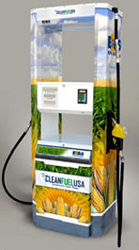A recent article by Red Herring reporter Justin Moresco called the need for ethanol distribution and retail infrastructure “Ethanol’s Unsexy Dilemma.”
Moresco quotes Karl Doenges of CleanFuel USA, Michelle Kautz with the National Ethanol Vehicle Coalition (NEVC), Robert White of the Ethanol Promotion and Information Council (EPIC) and Matt Hartwig with the Renewable Fuels Association (RFA), among others, about the challenge of making E85 available for the six million flex-fuel vehicles already on the road.
If each station assisted 300 of the flex-fuel vehicles on the road today, said Michelle Kautz of NEVC, there would have to be 20,000 stations.
 “I would say our biggest hurdle is the potential cost to the retailer of putting infrastructure in and the education needed to get customers to support that,” said Robert White, of the Ethanol Promotion and Information Council, a trade group.
“I would say our biggest hurdle is the potential cost to the retailer of putting infrastructure in and the education needed to get customers to support that,” said Robert White, of the Ethanol Promotion and Information Council, a trade group.
Putting in an E85 tank and dispenser costs from between $6,000 and $30,000, said Mr. Doenges, vice president and general manager for CleanFuel USA, which has equipped several hundred stations.
The simplest overhauls need a tank cleaned and a new dispenser. The big jobs—with all the “bells and whistles”—require ripping out concrete, adding new tanks and dispensers, and extending islands and canopies.
There are federal tax breaks and a growing number of state incentives for stations to add E85 infrastructure.
But Mr. Doenges said the other hurdle to ramping up E85 is the oil companies.
That’s why CleanFuel also acts as a distributor to bring ethanol to retailers. At the same time, change is happening.
Matt Hartwig of the Renewable Fuel Association said that ethanol storage tanks are popping up at terminals across the country.
“You see the infrastructure being put in place,” he said. And once the ethanol is at the terminals—even if it’s intended for E10—that will make the jump to higher blends easier in the future, he said.

